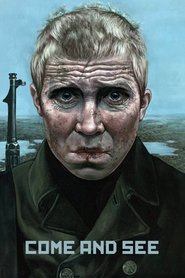One of the many excellent things about this harrowing movie is that, unlike almost all Western movies about the Third Reich, it doesn't take the Nazis own propaganda and self-conception of themselves (as an efficient, deep-thinking, noble, technologically superior and unbeatable killing machine, etc.) at face value.
Florya is still young. He seems younger than his years in early scenes, and much, much older in later ones.
The presence of what one might call the pure flame of love in the midst of unimaginable brutality is one of the great characteristics of Soviet war movies, differentiating such films from their Hollywood contemporaries, which tended to be more single-mindedly dedicated to masculine solidarity and action. A deep and savage regret for the human partings caused by warfare is a vital ingredient—perhaps the vital ingredient—of such masterpieces of the genre.[…]
The film is nationalistic [in] complicated ways, including the way it needed to pay attention to regional susceptibilities within the Soviet Union itself. The Nazi collaborators persecuting the Belorussians in Come and See are identified as neighboring Ukrainians [and] the legal prosecution of individuals responsible for giving orders on that fateful day was still a live issue when the movie was being put into production. […] But this wouldn’t be the first time that a propaganda movie (if that’s what this is) was also a cinematic masterpiece: Soviet cinema is full of such examples, from Eisenstein onward. For that, surely, is where any responsible account of Come and See needs to stake its final claim: the film is a masterpiece, after all, both in the quality of its imagination, and the magisterial way that it is structured.
[…]
It is an extraordinary coup for the film (and for Klimov as an artist) that the image on which [the 'Hitler'] sequence ends, the one surviving photograph of Hitler as a toddler sitting upright on his mother’s knee, should bear precisely the same fixed, unearthly stare—the same physiognomy almost—as Flyora himself, his would-be “assassin.”
— Mark Le Fanu (Criterion)
nd I saw when the Lamb opened one of the seals, and I heard, as it were the noise of thunder, one of the four beasts saying, Come and see. And I saw, and behold a white horse: and he that sat on him had a bow; and a crown was given unto him: and he went forth conquering, and to conquer.
— Revelation 6:1-17
Synopsis: The invasion of a village in Byelorussia by German forces sends young Florya into the forest to join the weary Resistance fighters, against his family's wishes. There he meets a girl, Glasha, who accompanies him back to his village. On returning home, Florya finds his family and fellow peasants massacred. His continued survival amidst the brutal debris of war becomes increasingly nightmarish, a battle between despair and hope.

